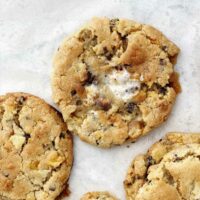
Seven Layer Cookies
With seven different mix-in's, these cookies are gooey, crunchy, buttery, and delicious all at once. Made with mix-in's like chocolate, butterscotch, marshmallows, corn flakes, and potato chips, they're the perfect blend of sweet and salty.
Servings 20 cookies
Equipment
Ingredients
- 2 cups [284 g] all-purpose flour
- 1 teaspoon baking powder
- ½ teaspoon baking soda
- 9 tablespoons [126 g] unsalted butter at room temperature
- ¾ cup [150 g] granulated sugar
- ¾ cup [150 g] brown sugar
- ¾ teaspoon salt
- 1 large egg
- 1 large egg yolk
- 1 tablespoon pure vanilla extract
- 1 cup [35 g] kettle potato chips
- 1 cup [35 g] corn flakes cereal
- 1 cup [50 g] mini marshmallows
- ½ cup [71 g] butterscotch chips
- ½ cup [71 g] mini chocolate chips
- 2 oz [56 g] Dulcey crunchy pearls
- 2 tablespoons cacao nibs chopped
- Flaky salt if desired
Instructions
- Adjust an oven rack to the middle of the oven. Preheat the oven to 400F [200C]. Line two sheet pans with parchment paper.
- In a medium bowl, whisk together the flour, baking powder, and baking soda.
- In the bowl of a stand mixer fitted with a paddle, beat the butter on medium speed until creamy, about 1 minute. Add the granulated and brown sugars and salt and beat on medium speed until light and fluffy, 2 to 3 minutes. Scrape down the sides of the bowl, add the egg, yolk, and vanilla, and mix until smooth. Add the flour mixture and beat on low speed until just combined. Add all potato chips, corn flakes, mini marshmallows, butterscotch chips, mini chocolate chips, white chocolate pearls, and cacao nibs and mix into the batter on low speed. Use a rubber spatula to give the dough a final mix and make sure it is completely combined.
- Form the dough into balls, about 2 tablespoons each [50 g], and place 8 cookies on each sheet pan. Sprinkle each cookie with a little flaky salt, if desired.
- Bake one pan at a time, rotating halfway through baking. Bake the cookies until the tops are golden brown and the cookies are slightly puffed and starting to crinkle, 10 to 11 minutes. Remove the baking sheet from the oven and use the back of a spatula to gently press the top of each cookie to flatten it. Let the cookies rest on the sheet pan for 5 minutes, then transfer them to a wire rack to finish cooling. Cookies are best slightly warm but can be stored in an airtight container at room temperature for up to three days. Cookies will soften the longer they sit.
Notes
- Cookie dough can be formed and refrigerated overnight, then baked the next day; the cookies may need an extra minute if chilled. Cookie dough can also be formed into balls and frozen for up to 2 weeks; let the cookies sit out at room temperature until the oven preheats. The cookies will need an extra minute if baked frozen.
- Most people who have made this cookie haven't had trouble with the bottoms browning too much, but a few have. If your bottoms are really dark/burnt after the 10 minute bake time, double check your oven temperature with an oven thermometer to make sure that your oven isn't running too hot. You could also try baking the cookies with two pans stacked to help.
- *The flattening with a spatula is inspired by both the Mokonuts’ Rye-Cranberry Chocolate Chunk Cookies by Dorie Greenspan and the Perfectly Chewy Peanut Butter Cookies by Jessie Sheenan; both these recipes require the cookies to be baked in balls and then flattened slightly to give them a gooey center and a crackly top.
Different brands of flour have varying levels of protein, ranging from low to high, which can result in very different outcomes when baking. I’ve found Gold Medal all-purpose unbleached flour to be the best option for many of my recipes; I use it in all the baked goods that don’t use yeast. For yeasted doughs that call for all-purpose flour, I like to use King Arthur Brand. If you are using White Lily flour, please note that it is a low protein flour and doesn’t absorb liquid the same as regular all-purpose flours. Check the back of the flour bag for instructions on substituting it for regular all-purpose flours.